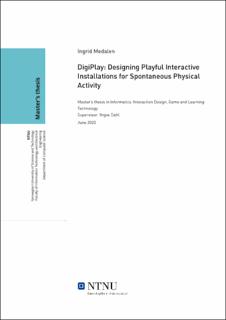| dc.contributor.advisor | Dahl, Yngve | |
| dc.contributor.author | Medalen, Ingrid | |
| dc.date.accessioned | 2021-09-15T16:02:26Z | |
| dc.date.available | 2021-09-15T16:02:26Z | |
| dc.date.issued | 2020 | |
| dc.identifier | no.ntnu:inspera:57394288:25603698 | |
| dc.identifier.uri | https://hdl.handle.net/11250/2777505 | |
| dc.description.abstract | Denne oppgaven undersøker om trenden hvor moderne teknologi fører til en mer stillesittende livsstil kan reverseres ved hjelp av lekne interaktive installasjoner. Hensikten er å utvikle en forståelse av hvordan vi kan designe lekne opplevelser ment for å fremme spontan fysisk aktivitet hos brukere. En brukersentrert tilnærming som resulterte i en prototype, og en summativ evaluering med observasjoner, loggdata, intervjuer og et spørreskjema ble gjennomført. Funnene var at brukerne ble trigget av konkurransen og evnen til å utvikle strategier. Muligheten til å justere mengden fysisk aktivitet ble også sett på som viktig, og de sosiale omgivelsene påvirket lysten til å prøve. Disse resultatene ble diskutert i forhold til begrepet lek og lekenhet, og sammenlignet med funn fra relevant forskning. Oppgaven konkluderer med at lekenhet kan brukes til å fremme spontan fysisk aktivitet og fem designretningslinjer som kan brukes til å informere design av interaktive installasjoner blir presentert: (1) Vurder nytten av konkurransebaserte elementer, (2) Legg til rette for mindre forutsigbare hendelser for å sikre variasjon og utvikling av strategier, (3) Sørg for at installasjonen er fysisk robust, (4) Gjør det mulig for brukerne å justere tempoet, (5) Husk på den sosiale konteksten når installasjonen plasseres. | |
| dc.description.abstract | This thesis investigates if the trend of modern technology leading to sedentary lifestyles can be reversed using playful interactive installations. The purpose is to develop an understanding of how we can design playful experiences intended to support spontaneous physical activity in users. A user-centered approach resulting in a prototype, and a summative assessment of the prototype using observations, log data, interviews and a questionnaire was conducted. The findings were that users were triggered by the competition and the ability to develop strategies. The ability to adjust the amount of physical activity was considered important, and the social surroundings influenced the willingness to try. These results were discussed in relation to the concept of play and playfulness and compared to findings of relevant research. The thesis concludes that playfulness can be used to promote spontaneous physical activity and five design guidelines that can be used to inform design of interactive installations are presented: (1) Consider the value of competitive elements, (2) Develop less predictable events to ensure variation and strategic development, (3) Ensure the solution is physically robust, (4) Enable users to adjust the pace, (5) Mind the social context when placing the installation. | |
| dc.language | | |
| dc.publisher | NTNU | |
| dc.title | DigiPlay: Designing Playful Interactive Installations for Spontaneous Physical Activity | |
| dc.type | Master thesis | |
